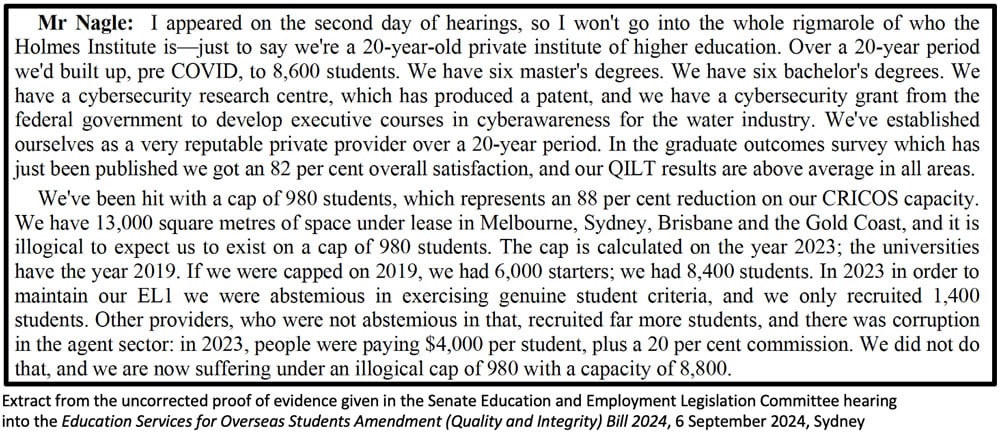Why private VET providers are hardest hit by student caps in Australia
The following is a guest post from Claire Field, which was originally published on her blog. Claire is the Principal of Claire Field and Associates, an independent consulting practice offering advice across VET, international education, higher education, and GenAI/EdTech issues. She previously held senior positions in the NSW and Australian governments, as well as in TAFE NSW and Mission Australia. Claire also served as the CEO of the Australian Council for Private Education and Training.
As the impact of the international student caps on our universities dominates the headlines, spare a thought for the high quality private VET providers who have never been involved in fraudulent activities or student exploitation. The best of them are decent, kind, dedicated entrepreneurs who have a passion for education.
Sadly they too are the collateral damage in the newly announced student visa caps – and the impact on their operations will be much more extreme than on any of our universities or TAFE Institutes.
While I personally agree with the government’s intention that tertiary education providers who teach international students should aim for a mix of domestic and international students (and we could debate what the ‘right’ mix of students should be), the fact is that it has never been an issue for private providers to operate institutions that focus exclusively (or almost exclusively) on educating international students.
Until now…
A total of 94,500 new international students will be able to enrol in VET next year (and 4,000 of those places will be reserved for providers with CRICOS applications currently under processing – they will get a cap of 30 students each – meaning that the Department of Employment and Workplace Relations is expecting more than 130 new CRICOS VET providers to be approved in 2025)…
The remaining places will be allocated as follows:
- specialist international VET providers (ie those with 80% or more international students) have collectively been given 61,505 new students
- non-specialist providers (ie under 80% of their students are internationals) will get a combined total of 18,953 new commencements
- TAFEs will get 5,482 new commencements, and
- new CRICOS providers which have only recently been registered will be allocated a total of 4,560 new commencements.
It is the first category where we are already starting to see staff laid off and in one case I heard of yesterday, a senior executive admitted to hospital following a nervous breakdown – after their institute was given a cap which is just 15% of their normal student numbers (ie their approved CRICOS capacity).
The reason why the caps are so damaging to VET providers is that in VET ‘new students’ are almost the same as ‘total’ students in any given year because many VET courses are only ~12 months long.
The institution above had only recently taken out a 10 year lease on 4 new floors in the CBD of one of our capital cities and had invested millions in a high class fitout.
This institution is not a ghost college. It’s not an elite university with extensive financial reserves it can draw on – but it is an employer and a tenant in a capital city where landlords are finding it hard to get offices leased.
After receiving their student cap late last week, the next day this institution immediately had to make some of their staff redundant.
This is not a ‘shonk’ operating a ghost college.
It is an entrepreneur offering quality education to genuine students coming to Australia to learn new skills.
Sadly, of course, this institution is not alone…
While private higher education providers typically offer longer programs of study than VET providers, speaking before the Senate Committee hearing into the ESOS legislation in Sydney on Friday, Stephen Nagle from Holmes Institute had the courage to share the following about the impact of the caps on his institution:

Other details that we know, about the impact on private providers include:
ASX-listed Edu Holdings notified the ASX on Tuesday of the impact of the caps on their VET provide, Australian Learning Group. They have been given a cap of 447 new international VET students which is approximately half of the new students they enrolled in 2023 (-51%) and a -57% reduction on total new students enrolled this year. However, because their students typically undertake a two-year program “the decline is likely to be gradual”. Their higher education provider, Ikon Institute, had previously been given a cap for 2025 of 200 new international higher education students (which is down on the 347 new students they enrolled in 2023 and the 784 new commencements YTD in 2024). They noted that they “expected to benefit from their progressive enrolment growth during FY24 and its 3-4 year average study duration for a number of years.”
NextEd Group is another ASX-listed education organisation educating international VET and higher education students. They have a combined CRICOS capacity across their colleges of almost 27,000 students and in February and April 2024 opened new campuses in Adelaide and the Gold Coast. They have been given a cap for their VET operations of 1,139 for 2025 which is down on the 2,078 new commencing international VET students they enrolled in 2023 and the YTD 2,636 in 2024. (They have also advised that the cap for their higher education provider, Academy of Interactive Technology, will be 100 students which is below their 2023 new international student enrolments of 172, but above their YTD 2024 new international students of just 72.)
Other CRICOS VET providers I am aware of have been given the following caps relative to their CRICOS capacity. (Note that I have deliberately not given precise figures to avoid them being identified. It is for them to decide when/if they wish to share the details):
- Cap <40 new students, CRICOS capacity approx. 800 students
- Cap: <200 new students, CRICOS capacity approx. 400 students
- Cap: <400 new students, CRICOS capacity approx. 1,200 students
Against this backdrop I was unsurprised to learn that an online meeting on Monday to discuss the caps attracted more than 250 people, and that providers are exploring the possibility of legal action…
















